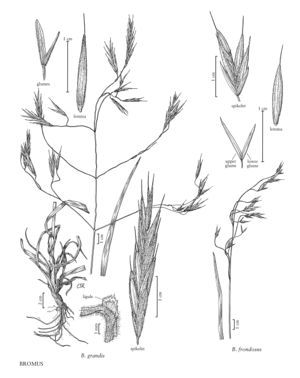Difference between revisions of "Bromus frondosus"
imported>Volume Importer |
imported>Volume Importer |
||
| Line 39: | Line 39: | ||
|publication year= | |publication year= | ||
|special status= | |special status= | ||
| − | |source xml=https://bitbucket.org/aafc-mbb/fna-data-curation/src/ | + | |source xml=https://bitbucket.org/aafc-mbb/fna-data-curation/src/200273ad09963decb8fc72550212de541d86569d/coarse_grained_fna_xml/V24/V24_297.xml |
|subfamily=Poaceae subfam. Pooideae | |subfamily=Poaceae subfam. Pooideae | ||
|tribe=Poaceae tribe Bromeae | |tribe=Poaceae tribe Bromeae | ||
Revision as of 16:22, 11 May 2021
Plants perennial; not rhizomatous. Culms 50-100 cm, erect to spreading; nodes 3-5, usually glabrous, rarely pubescent; internodes glabrous. Sheaths usually glabrous, sometimes pubescent or pilose, especially the lower sheaths, midrib of the culm leaves usually narrowed just below the collar; auricles absent; ligules 1-3 mm, glabrous, truncate to obtuse, laciniate; blades 10-20 cm long, 3-6 mm wide, flat, often glaucous, usually glabrous, sometimes scabrous, basal blades often pubescent. Panicles 10-20 cm, open; branches ascending and spreading or declining and drooping. Spikelets 15-30 mm, elliptic to lanceolate, terete to moderately laterally compressed, with (4)5-10 florets. Glumes usually glabrous, rarely slightly pubescent, 3-veined; lower glumes 5.5-8 mm; upper glumes 6.5-9 mm, often mucronate; lemmas 8-12 mm, elliptic to lanceolate, rounded over the midvein, backs pubescent or glabrous, margins usually with longer hairs, apices subulate to obtuse, entire; awns 1.5-4 mm, straight, arising less than 1.5 mm below the lemma apices; anthers 1.5-3.5 mm. 2n = 14.
Distribution
Utah, Ariz., Colo., N.Mex.
Discussion
Bromus frondosus grows in open woods and on rocky slopes, at 1500-2500 m. Its range extends from Colorado, Arizona, and New Mexico into Mexico.
Selected References
None.
